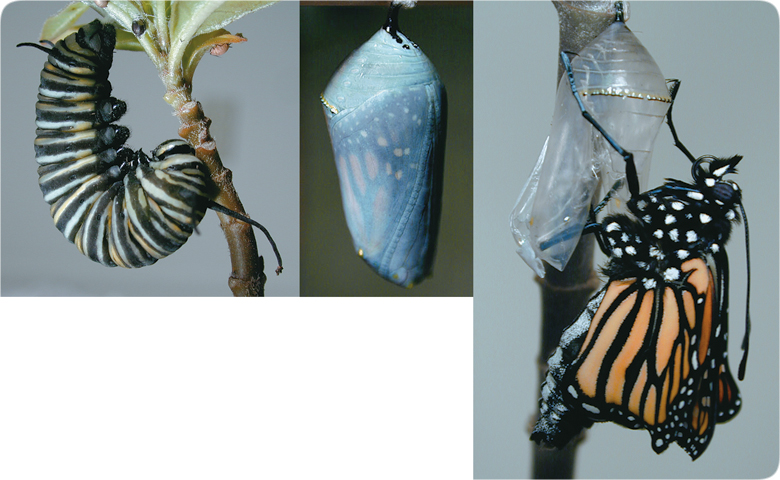Below is the online edition of In the Beginning: Compelling Evidence for Creation and the Flood,
by Dr. Walt Brown. Copyright © Center for Scientific Creation. All rights reserved.
Click here to order the hardbound 8th edition (2008) and other materials.
35. Metamorphosis

Figure 16: Metamorphosis. Many animals experience an amazing transformation that refutes evolution. One example is the monarch butterfly. As a two-week-old caterpillar (left), it builds a chrysalis around itself (center). Then its complex organs disintegrate. From an evolution perspective, this should cause the insect’s extinction—a thousand times over. Two weeks later, a beautiful butterfly emerges with different and even more remarkable capabilities (right). Some people might believe that a complex machine, such as an automobile, evolved by natural processes, but if they saw that machine disintegrate and, two weeks later, reemerge as an airplane, only the most naive and unscientific would still believe that natural processes could produce such a marvelously designed automobile and airplane.
Most insects (87%) undergo complete metamorphosis. It begins when a larva (such as a caterpillar) builds a cocoon around itself. Then, its body inside disintegrates into a thick, pulplike liquid. Days, weeks, or months later, the adult insect emerges—one that is dramatically different (as shown in Table 1), amazingly capable, and often beautiful, such as a butterfly. Food, habitat, and behavior of the larva also differ drastically from those of the adult.
Evolution claims that:
Mutations slightly alter an organism’s genetic material, which later generations inherit. On rare occasions the alterations are beneficial, enabling those offspring to reproduce more of themselves and the improved genetic material. After many generations, dramatic changes—even new organs—accumulate.
If this were true, each organism would have to be able to reproduce and be superior, in some sense, to its ancestors. How then could metamorphosis evolve in many stages?a
What mutations could improve a larva? Certainly, none that destroyed its nerves, muscles, eyes, brain, and most other organs, as occurs within a cocoon. So, even if a larva improved, it later ends up as “mush.” From an evolutionary standpoint, liquefying complex organs is a giant step backwards. As Michael Pitman wryly noted,
Maggots will more or less dissolve themselves when developing into a fly. Was the process pre-programmed from the first “production run”? Or was the ancestral fly a dissolved maggot?b
The millions of changes inside the thick liquid never produce something survivable or advantageous in the outside world until the adult completely forms. How did the genetic material for both larva and adult develop? Which came first, larva or adult? What mutations could transform a crawling larva into a flying monarch butterfly that can accurately navigate 3,000 miles using antennae and a tiny brain?c Indeed, why should a larva evolve in the first place, because it cannot reproduce?d
Charles Darwin wrote,
If it could be demonstrated that any complex organ existed which could not possibly have been formed by numerous successive, slight modifications, my theory would absolutely break down.e
Based on metamorphosis alone, evolution “breaks down.”
Obviously, the vast amount of information that directs every stage of a larva’s and an adult’s development, including metamorphosis, must reside in its genetic material at the beginning. This fits only creation.